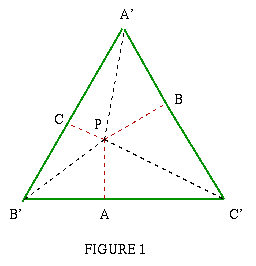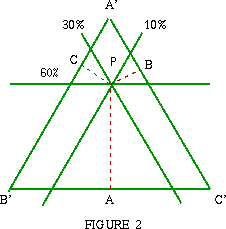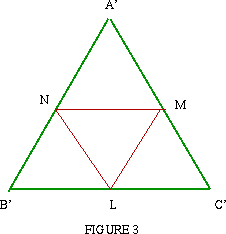Copyright © University of Cambridge. All rights reserved.
'Three Way Split' printed from https://nrich.maths.org/
Show menu
 A'B'C' is an equilateral
triangle. For any point P inside it, the area of A'B'C' is an equilateral
triangle. For any point P inside it, the area of  A'B'C' is equal to the sum of the areas of the triangles PB'C' ,
PC'A' and PA'B'
A'B'C' is equal to the sum of the areas of the triangles PB'C' ,
PC'A' and PA'B'
PA, PB and PC are the heights of triangles PB'C', PC'A' and PA'B'. If the length of the side of the equilateral triangle is L units, then: Area PA + PB + PC = (2 x Area |
 |
For each position of the point P inside
the equilateral triangle we can take PA, PB and PC to represent the
percentages of something which is split into three parts, the total
being represented by PA +PB +PC . As P moves closer to A' the
length PA increases and when P coincides with A' we have PB = PC =
0. We can label the vertices of the triangle to represent the three
parts so that PA gives the percentage of A', PB gives the
percentage of B', and PC gives the percentage of C'. Suppose, for
example, these percentages are 60%, 30% and 10% respectively. If we
draw an equilateral triangle with sides of length L = 200/
 3 then PA + PB + PC = 100. 3 then PA + PB + PC = 100. |
|
| To find the position of P draw lines parallel to the sides of the triangle as shown in the diagram such that anywhere on the 60% line the perpendicular distance between this line and the line B'C' = 60 so PA = 60, similarly the distance between the 30% line and the line C'A' is 30 units so that PB = 30, and the distance between the 10% line and the line A'B' is 10 units so that PC = 10. Because PA + PB + PC = 100 (as we have shown) these three lines intersect in a single point. |  |
We apply this to the percentage of
votes given to three parties A', B' and C' in an election (where
there are no other candidates.) Points L, M and N are the midpoints
of the sides of  A'B'C'. A'B'C'.
If the point P lies on NM then height PA is half the height of
Similarly, if P is inside |
 |